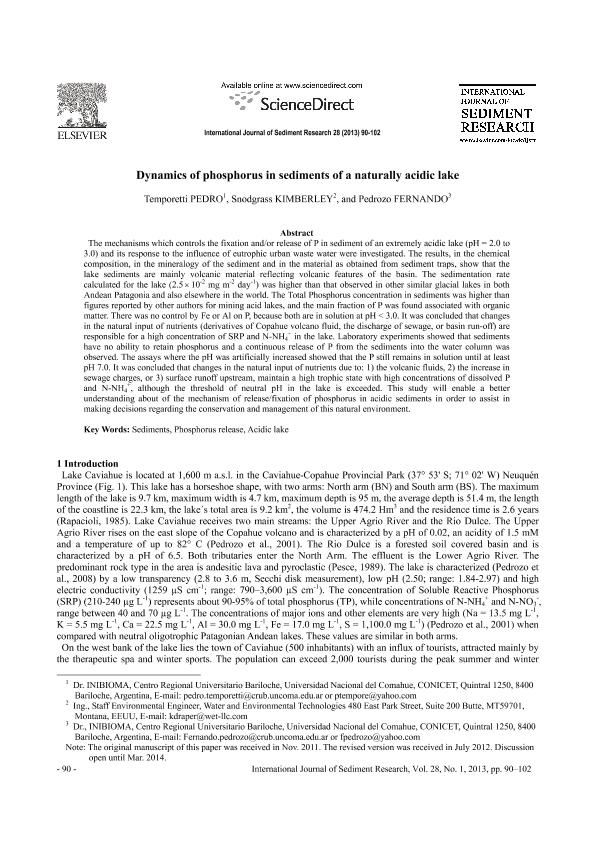Mostrar el registro sencillo del ítem
dc.contributor.author
Temporetti, Pedro Felix

dc.contributor.author
Snodgrass, Kimberley
dc.contributor.author
Pedrozo, Fernando Luis

dc.date.available
2016-07-27T18:27:38Z
dc.date.issued
2013-01
dc.identifier.citation
Temporetti, Pedro Felix; Snodgrass, Kimberley; Pedrozo, Fernando Luis; Dynamics of Phosphorus in sediments of a naturally acidic lake; Elsevier; International Journal of Sediment Research; 28; 1; 1-2013; 90-102
dc.identifier.issn
1001-6279
dc.identifier.uri
http://hdl.handle.net/11336/6721
dc.description.abstract
The mechanisms which controls the fixation and/or release of P in sediment of an extremely acidic lake (pH = 2.0 to 3.0) and its response to the influence of eutrophic urban waste water were investigated. The results, in the chemical composition, in the mineralogy of the sediment and in the material as obtained from sediment traps, show that the lake sediments are mainly volcanic material reflecting volcanic features of the basin. The sedimentation rate calculated for the lake (2.510−2 mg m−2 day−1) was higher than that observed in other similar glacial lakes in both Andean Patagonia and also elsewhere in the world. The Total Phosphorus concentration in sediments was higher than figures reported by other authors for mining acid lakes, and the main fraction of P was found associated with organic matter. There was no control by Fe or Al on P, because both are in solution at pH < 3.0. It was concluded that changes in the natural input of nutrients (derivatives of Copahue volcano fluid, the discharge of sewage, or basin run-off) are responsible for a high concentration of SRP and N-NH4+ in the lake. Laboratory experiments showed that sediments have no ability to retain phosphorus and a continuous release of P from the sediments into the water column was observed. The assays where the pH was artificially increased showed that the P still remains in solution until at least pH 7.0. It was concluded that changes in the natural input of nutrients due to: 1) the volcanic fluids, 2) the increase in sewage charges, or 3) surface runoff upstream, maintain a high trophic state with high concentrations of dissolved P and N-NH4+, although the threshold of neutral pH in the lake is exceeded. This study will enable a better understanding about of the mechanism of release/fixation of phosphorus in acidic sediments in order to assist in making decisions regarding the conservation and management of this natural environment.
dc.format
application/pdf
dc.language.iso
eng
dc.publisher
Elsevier

dc.rights
info:eu-repo/semantics/openAccess
dc.rights.uri
https://creativecommons.org/licenses/by-nc-nd/2.5/ar/
dc.subject
Sediments
dc.subject
Phosphorus Release
dc.subject
Acidic Lake
dc.subject.classification
Otras Ciencias Naturales y Exactas

dc.subject.classification
Otras Ciencias Naturales y Exactas

dc.subject.classification
CIENCIAS NATURALES Y EXACTAS

dc.title
Dynamics of Phosphorus in sediments of a naturally acidic lake
dc.type
info:eu-repo/semantics/article
dc.type
info:ar-repo/semantics/artículo
dc.type
info:eu-repo/semantics/publishedVersion
dc.date.updated
2016-07-22T18:53:21Z
dc.journal.volume
28
dc.journal.number
1
dc.journal.pagination
90-102
dc.journal.pais
Países Bajos

dc.journal.ciudad
Amsterdam
dc.description.fil
Fil: Temporetti, Pedro Felix. Consejo Nacional de Investigaciones Científicas y Técnicas. Centro Científico Tecnológico Patagonia Norte. Instituto de Investigación En Biodiversidad y Medioambiente; Argentina
dc.description.fil
Fil: Snodgrass, Kimberley. State University Of Montana. Department Of Earth Sciences; Estados Unidos
dc.description.fil
Fil: Pedrozo, Fernando Luis. Consejo Nacional de Investigaciones Científicas y Técnicas. Centro Científico Tecnológico Patagonia Norte. Instituto de Investigación En Biodiversidad y Medioambiente; Argentina
dc.journal.title
International Journal of Sediment Research

dc.relation.alternativeid
info:eu-repo/semantics/altIdentifier/url/http://www.sciencedirect.com/science/article/pii/S1001627913600219
dc.relation.alternativeid
info:eu-repo/semantics/altIdentifier/doi/10.1016/S1001-6279(13)60021-9
dc.relation.alternativeid
info:eu-repo/semantics/altIdentifier/doi/http://dx.doi.org/10.1016/S1001-6279(13)60021-9
Archivos asociados
